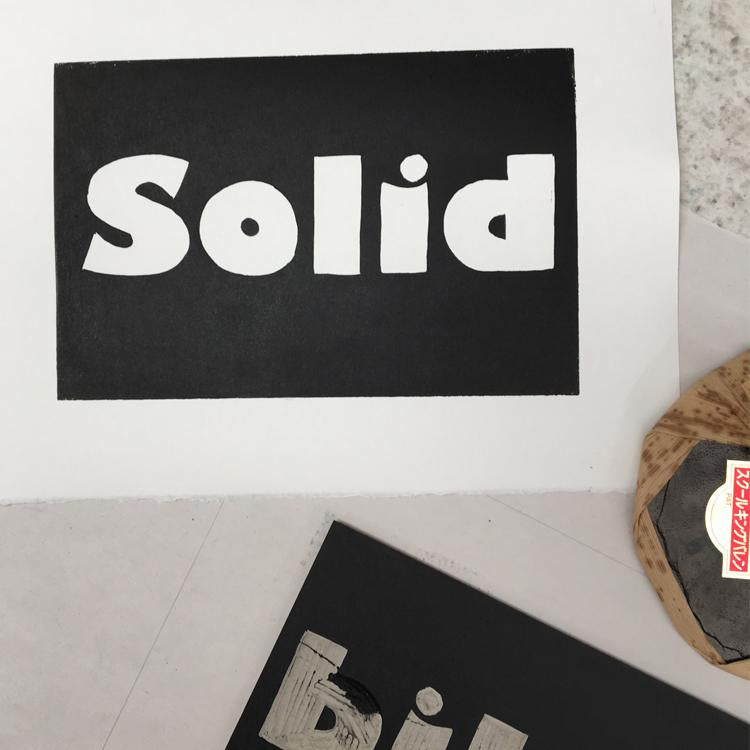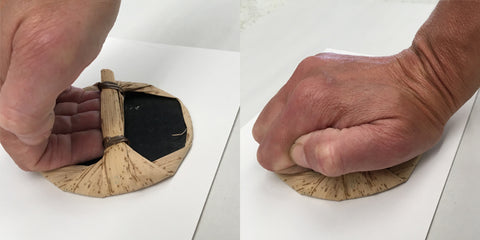Printing a Solid Lino Block with a Baren

One of the hardest things to do when printing a relief block (lino, vinyl or wood) is to print solid blocks of colour.
There are quite a few choices to make and if you get these right then your printing will be much easier.
- Ink – an oil based ink will print better than a waterbased one. It will stay open for longer on the slab which will allow you to print over a longer period
- Paper – printing by hand is easier with thinner paper. The paper should also be very smooth – any texture in the paper will appear in your print.
- Roller – the best quality you can afford and then look after it making sure you clean it well after each printing session. We love the Hawthorn rollers they have a large diameter and are soft. Make sure your roller is clean and free from dents or dried ink –
any texture on your roller will transfer to the print surface with will transfer to your print. If possible use a roller that is wider than your
block. - Printing surface – before you cut make sure it is really smooth with no dents or mountains – a quick rub over with a sanding block and some water will
help if using traditional lino. - Printing surface – after cutting give the lino a brush with an old nail/toothbrush to eliminate any stray bits of lino and if using traditional hessian
backed lino make sure no bits of the backing are coming loose – snip any stray bits away so they do not raise up and get inked.
When rolling out your ink it is tempting to roll out a thick layer onto the inking slab.
One of the ways to know that your ink is not going to be too thick is the noise it makes when being rolled out. It should sound tacky and definitely not
squelchy. It should look like a very short smooth velvet and the ink should be flat not at all peaked.
squelchy. It should look like a very short smooth velvet and the ink should be flat not at all peaked.
Rolling out a thick layer can lead to a few problems.
- The print paper can slide giving you a smudgy image
- Fine lines can be filled in with ink, loosing definition of your cut marks
- Ink will be uneven on the surface of the print and will make the drying time excessive
If printing a solid, flat colour then ink in several directions. Try not to put the roller down on the lino or lift up from the lino at 90′ – this will give you stripes of ink – think of your roller like an aeroplane landing or taking off! Don’t put pressure on the roller, this will push ink into the cut lines. Try to keep the roller flat to the lino so you do not ink up the edges.

How you hold the baren is crucial. The handle is very short and it seems impossible at first to understand how you hold it. You should just tuck the tips
of your fingers under the strap and then fold down the rest of your hand to so that your knuckles and the heel of your hand is touching the baren.

You want to print using a circular motion putting lots of weight through the whole of your hand. A piece of silicon/baking paper is useful between the baren and the paper. This is for a couple of reasons. If printing on finer paper the silicon paper will stop the baren wearing bits of the paper away.
The silicon paper will also help you to put lots of pressure through the baren but will allow it to still glide over the surface. Try to keep the baren flat to the paper – especially at the edges so that you get sharp lines. The technique of holding a baren is the same if it is a simple bamboo one or a highly engineered ball bearing one.
The ball bearing ones allow you to print large areas with less pressure.
The first print you take from a piece of lino always seems to be a little patchy and less dense in colour. After a couple of prints the transference of ink will improve.

This speckled effect on the print is down to two issues – the paper is a little textured and the inking was insufficient. If you print using Ternes Burton Pins and Tabs you could re ink and print again to resolve this issue. The Ternes Burton system is brilliant – not just for reduction printmaking but also for ensuring that your print block is placed in the correct position on your paper. Paper is an expensive part of printmaking so not wasting any is crucial.

A small speck of something (possibly a piece of stray lino) had stuck to the plate whilst inking up. This foreign body held the paper away from the ink
so creates an area that will not print.

